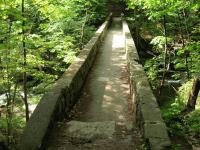
Wire Mill, Hallowell, ca. 1880
Hubbard Free Library
Out of the many industries along the Bombahook and Vaughan Stream, the Kennebec Wire Company was an important one in Hallowell’s history. Established in ca.1870 by Henry Harding, the company imported huge coils of wire (1/4 inch in diameter) from Boston and Portland. They then put the huge coils through a machine that reduced them into suitable sizes.
This factory continued working for about ten years and then was taken over by a man named Benjamin Tenney. Benjamin Tenney was a successful Hallowell business man who also owned the Sandpaper Mill further up Vaughan Stream and was later to become the mayor of Hallowell. Tenney converted the wire mill into an isinglass factory. Isinglass was a clarifier put into beer made out of fish gills and tongues. After four years, a more economical and efficient way of creating the isinglass was discovered, and the factory closed down.

Arch Bridge, Vaughan Woods, Hallowell, ca. 1932
Courtesy of Sumner A. Webber, Sr., an individual partner
Later, the Hallowell Light and Power Company took over the building. They used wires from different wire mills to connect wires to houses and bring electricity. The electricity had a major impact in daily life in historic Hallowell. Before electricity, people had to do everything by candlelight: reading, writing, and eating. But with electricity, lights could stay on late at night, and the risk of fires from the candles was gone. Wire mills stayed about the same throughout the rest of the 1800s and into the early 1900s, using simple machines to cut wire down to the desired size. Wire mills still exist today, but workers use high-tech machines to cut the wire and shrink it to a certain diameter. In conclusion, wire mills were a very important industry in historic Hallowell and also throughout the world.

The Wire Mill Dam, Vaughan Woods, Hallowell, ca. 1910
Courtesy of Sumner A. Webber, Sr., an individual partner